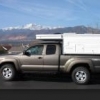Edited by Beach, 13 January 2019 - 03:15 PM.
Electricity while off grid
#11

Posted 13 January 2019 - 03:12 PM
#12

Posted 13 January 2019 - 03:23 PM
Battle Born batteries. Made in the USA!smlobx
Any recommendations for lithium batteries?
https://battlebornbatteries.com/
Edie to add that Advmoto also suggested them.
Edited by smlobx, 13 January 2019 - 03:27 PM.
Eddie
KO4CPL
Travel light. Travel far. Travel safe.
#13

Posted 14 January 2019 - 02:47 AM
Vic Harder:
Nice setup!
I have a Tacoma. How does one resolve the charging voltage issue you mentioned?
There are a number of ways. First step though, is to be sure you have a problem. To do that, you need meters/gauges or be handy with a VOM or both. Most folks figure out they have an issue when the house battery dies "too soon".
To be clear, the issue is that the alternator/truck battery are about 25' away from your house batteries, as the electron flows. As the current flows from your alternator to the house battery, it loses impetus, or voltage. There is a "Voltage drop". The more current, the more the drop. If the voltage at the alternator starts off at too low a level (as is the case with Toyota's), there isn't enough left to actually charge the house battery when it gets there. The cause is related to the stock wiring as installed by the factory, which uses RV standard 14g or 12g wire. When you try to push 20+Amps through that wire, the voltage drops too much to actually be able to charge your house batteries, and the battery separator disconnects the two batteries = no charging.
Fixes?
1) Thicker wires
2) Manually override the battery separator
3) CTEK DS250 to bump up the voltage at the source
4) Rely on solar to charge the house batteries.
Check out my thread that I created as I was figuring all this out for my Hawk build - http://www.wanderthe...e-power-scotty/
2012 ATC Puma Shell build - https://www.wanderth...012-puma-build/
Power considerations thread - https://www.wanderth...e-power-scotty/
Building out an electrical system - So, you want to setup a good electrical system in your camper? - Electrical, Charging, Solar, Batteries and Generators - Wander the West
#14

Posted 14 January 2019 - 04:49 AM
What I'm trying to figure out is if I would install a 2nd battery under my truck hook and wire it up to my alternator, then that battery will be used exclusively for my camper. When I'm driving my truck, the alternator will be charging the 2nd battery and of course the main battery for the truck.
JoeKan, I suggest you search the web for "dual battery setup" to find some write ups and video. What you want is not uncommon and should be very doable. But I caution, the whole charging batteries subject can get involved, have possible pitfalls, gotchas etc.
I'm unclear about your reference to ISO wire. I'd suggest battery wire (or equivalent) to the second battery and automotive wire (or equiv) to the camper.
Hooking up the charging wire to the truck battery positive terminal rather than the alternator might be easier.
Tough to estimate material costs; much depends on the battery selected. For the charge wire size, I'd use the existing alternator to truck battery wire gauge as a reference and prob go no bigger.
Battery sizing depends on number days worth of power you want to build for. As said, your power needs are relatively low.
As an example of calculating needs ... LEDs might use 4watts, so say 2 lights for 6 hrs = ~4 amp hours [ (2 x 4w x 6hrs) / 12v ]. Plus recharging an IPAD might be ~4 Ahs. Say you want to charge the equivalent of 2. So total of 12 Ah possible requirement per 24 hrs.
HTH some
#15

Posted 14 January 2019 - 02:55 PM
There are a number of ways. First step though, is to be sure you have a problem. To do that, you need meters/gauges or be handy with a VOM or both. Most folks figure out they have an issue when the house battery dies "too soon".
To be clear, the issue is that the alternator/truck battery are about 25' away from your house batteries, as the electron flows. As the current flows from your alternator to the house battery, it loses impetus, or voltage. There is a "Voltage drop". The more current, the more the drop. If the voltage at the alternator starts off at too low a level (as is the case with Toyota's), there isn't enough left to actually charge the house battery when it gets there. The cause is related to the stock wiring as installed by the factory, which uses RV standard 14g or 12g wire. When you try to push 20+Amps through that wire, the voltage drops too much to actually be able to charge your house batteries, and the battery separator disconnects the two batteries = no charging.
Fixes?
1) Thicker wires
2) Manually override the battery separator
3) CTEK DS250 to bump up the voltage at the source
4) Rely on solar to charge the house batteries.
Check out my thread that I created as I was figuring all this out for my Hawk build - http://www.wanderthe...e-power-scotty/
Thanks Vic.
Your thread was on my list to read, and I should have done so before jumping in. It is SO useful and covers in detail the fixes you list, especially the CTEK D250SA charger and Smartpass relay. Hopefully they will solve the charging problems with my Tacoma + ATC Bobcat with solar panel, and provide an upgrade to the stock (and frankly cheap) VSR and PWM controller.
I noticed here that you agree with Herve that "I won't be able to jump the starter battery or trickle charge it if I don't have the Smartpass and bigger wires, but I can always use jumper cables in that rare case". Is this really the case? I was hoping to buy only the charger, but also want to be able to use a trickle charger during long periods of storage.
As a cross-reference, I've included your link on the function of the Smartpass.
Cheers.
#16

Posted 14 January 2019 - 05:37 PM
Battleborn do seem to be the easiest and best supported 'drop in' lithium replacements.
To be clear, these are not actually 'made in the USA', but are assembled from Chinese cells in Reno. As far as I know, there are no US manufacturers of LiFePO4 cells.
What you are paying the premium for is excellent customer service and support.
Battle Born batteries. Made in the USA!
https://battlebornbatteries.com/
Edie to add that Advmoto also suggested them.
2016 Fleet Flatbed
2016 Toyota Tacoma
#17

Posted 14 January 2019 - 07:44 PM
Just a few notes on the D250SA in case the info may be helpful to someone. I've been running one in my rig since October 2017 and am happy with it but I may not be the typical FWC user. I have a D250SA but I don't have the SMARTPASS. I'm only running a single battery and use it for LED lights and furnace only (I use a cooler for refrigeration). I don't use the solar-charging portion of it as I've not found it necessary. As far as control leads, I have the black one grounded to the frame to select a bulk charging voltage of 14.7 volts for the AGM battery. The voltage is temperature-compensated so when I say 14.7, what I actually see at, say, 45 degrees F, is voltage in the 15.0 range while my alternator is putting out 14.1 cold and mid 13's warm. The red lead isn't used as my Tundra doesn't have an ECU-controlled alternator. I only have 8-gauge wire running to it from the truck's starter battery (and a fuse in the positive line).
My Lifeline battery (GPL-31T) is eight years old and probably only capable of storing 80-some per cent of its original 105 amp-hour capacity at this point. Nevertheless, that has been enough for my modest needs. I drive (and therefore charge) daily, I don't run the furnace overnight, and I charge my electronics (GPS, Inreach, iPad, two phones, two cameras, dashcam, a laptop, and sometimes my brother's CPAP) in the truck. When the weather's warm enough I don't need to run the furnace, the battery is of course massive overkill for the short time I use an LED light or two (and I don't have a fan in my rooftop vent).
One downside of the D250SA is it doesn't have a LiFePO4 charging profile. I sometimes think I'd like to go to a LiFePO4 battery when the Lifeline finally can't handle the load. If I had to do that now, I'd probably be going with a Redarc BCDC1225D or similar DC-to-DC charger for it. But that's a lot of money by the time you add up the more expensive LiFePO4 battery and the charger and necessary gear. For my current needs, I'd probably be smarter to just replace the battery and let the D250SA keep it happy.
.
Edited by Old Crow, 15 January 2019 - 12:24 AM.
'01 FWC Hawk shell on a '13 Tundra Double-Cab + '19 Ford Transit van with Quigley 4x4 option
#18

Posted 14 January 2019 - 10:25 PM
Thanks Vic.
Your thread was on my list to read, and I should have done so before jumping in. It is SO useful and covers in detail the fixes you list, especially the CTEK D250SA charger and Smartpass relay. Hopefully they will solve the charging problems with my Tacoma + ATC Bobcat with solar panel, and provide an upgrade to the stock (and frankly cheap) VSR and PWM controller.
I noticed here that you agree with Herve that "I won't be able to jump the starter battery or trickle charge it if I don't have the Smartpass and bigger wires, but I can always use jumper cables in that rare case". Is this really the case? I was hoping to buy only the charger, but also want to be able to use a trickle charger during long periods of storage.
As a cross-reference, I've included your link on the function of the Smartpass.
Cheers.
Thanks for the prompt to re-read the info about the CTEK devices. High charging currents from the alternator to the camper batteries will always benefit from bigger wires. And even in my setup, with 2g wire and the ML-ACR, I can't see wanting to run through those wires to "jump" start my truck. If my truck battery dies, I think I have other issues and would want to keep the two systems isolated while I jump start the truck with proper cables and a buddy's running truck.
Trickle charging... I'm not sure I know which direction you want to charge what with. Are you talking about the built in IOTA or some charger you stick on a battery? Which one, house or camper?
And why not add the Smartpass into the mix if you anticipate needing to jump and/or use it for trickle charging?
2012 ATC Puma Shell build - https://www.wanderth...012-puma-build/
Power considerations thread - https://www.wanderth...e-power-scotty/
Building out an electrical system - So, you want to setup a good electrical system in your camper? - Electrical, Charging, Solar, Batteries and Generators - Wander the West
#19

Posted 15 January 2019 - 03:06 AM
Vic,
The wire size of most consumer jumper cables is typically 6 ga. One may wonder, "why don't the jumper cable wires just get so hot they melt?" I think the answer is that there is a limited time of high current during cranking while jumping (maybe 30 sec or less).
I made a spreadsheet to do a calculation for wire size based on current and time
6 ga wire will handle 100 A continuously for about 30 sec. Once the engine fires (and even during cranking) tit seems to me that the vehicle alternator will start charging the battery too, taking some of the load off of the jumper battery.
Perhaps someone else has better insight into this.
It seems to me that 4 ga or even 6 ga wires should be large enough for "self jump" using a two battery setup.
1993 Dodge Cummins W-250 Club Cab long bed, 2007 FWC Keystone
#20

Posted 15 January 2019 - 03:35 AM
Some rental RV's have a "self jump" mechanism built in.
Not sure the wiring size so no help there.
Fairly certain it simply redirects the house battery to under the hood.
David Graves
0 user(s) are reading this topic
0 members, 0 guests, 0 anonymous users
















